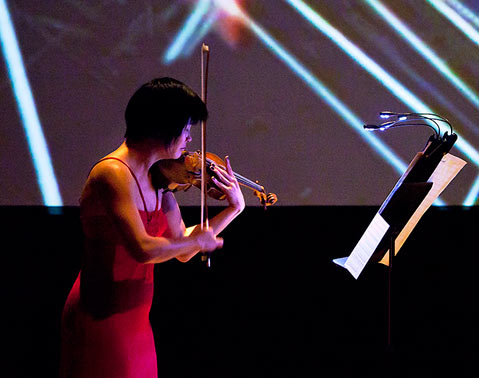Jennifer Koh at the Music Academy of the West’s Hahn Hall
Solo Violinist Performed with Video Art on Tuesday, May 17

In this program, solo violinist Jennifer Koh achieved an impressive balance between outright virtuosity and probing, intellectually stimulating juxtapositions. Using the partitas for solo violin of J. S. Bach as a point of departure, Koh explored connections between older and contemporary music. The result was one of the year’s most interesting performances. She opened with Bach’s Partita No. 3 in E Major, BWV 1006. Dressed in a fiery red gown, Koh summoned a huge, super-expressive tone from her 1727 Ex Grumiaux Ex General DuPont Stradivari. From there, she segued directly into the Sonata No. 2 in A Minor, Op. 27, No. 1 of Eugène Ysaÿe without a break, the better to highlight a direct quotation of the Bach E Minor partita that comes early in the piece. (For those who happened to have attended the lecture given by music critic Alex Ross at UCSB earlier this season, the entire evening was an ideal demonstration of Ross’s thesis about the persistence of the chaconne.)
After the strenuous exertion of the Ysaÿe, which is a spectacularly demanding piece, Koh stopped to catch her breath and speak a little about the intent of this project, which she calls “Bach and Beyond.” Her remarks were a restatement of what she eloquently expressed in her program notes: that “contemporary music re-creates the thread with which we can connect back to past works of art. Contemporary music makes music from all time periods more transparent to the listener and also to the performer.” To make this claim concrete and vivid, all Koh had to do was pick up her bow again and play another two pieces in a row, this time two contemporary works, the Nocturne—In memory of W. Lutosławski by Finnish composer Kaija Saariaho, and the Fantasy—Remembering Roger of Elliott Carter. This is rugged stuff, full of rasping harmonics and skirling dissonance, but Koh kept it musical and embraced the compositional connections to Bach with the same intense focus she had devoted to the Ysaÿe.
One last piece remained on the first half of the program, and it was a great one. The “Lachen verlernt” of Esa-Pekka Salonen is another iteration of the chaconne, this time replete with all the extravagant touches that a hyper-imaginative contemporary composer can bring to the ancient bass figure. In addition to Koh’s superb playing, the audience was treated to a multimedia presentation involving the simultaneous projection of a video created by artist Tal Rosner. The large screen was at first filled with jittery straight lines that moved in such a way as to suggest the title “Sonata for Violin and Screensaver,” but before the piece was out, Rosner had elaborated his images to include abstract squiggles and even a peaceful nocturnal skyline that resembled Los Angeles.
Following the intermission, Koh returned for more straight-ahead Bach—the Partita No. 2 in D Minor, BWV 1004. Her playing was brilliant, and, through the lens of her contemporary explorations, the view of the great 18th-century composer’s genius was, as she had claimed, transparent.



